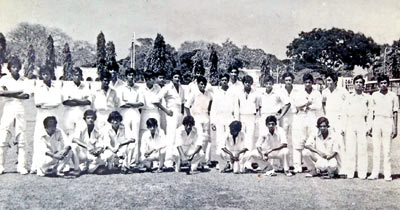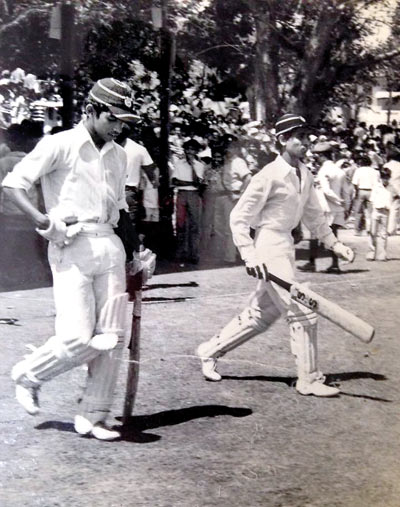What I Learnt from Cricket

The Royal College cricket squad of that year
Playing in the Royal-Thomian and wearing the Blue and Gold striped cap was the dream of every budding cricketer in the school. I first turned out for the College First XI unexpectedly in the inaugural Royal-Thomian 50 over encounter in 1975. I subsequently played in the Royal-Thomian Big Match. The journey to the Royal-Thomian was about learning; it was about learning to play the game of life. I believe we learnt more about life on the field than in the classroom. Our Chemistry teacher and under-16 Cricket master-in-charge was Ernest Amarasekara, whom we called ‘Erna’. At a practice session on the field, one day, he came from behind and slapped me hard on my back. I was shocked and shaken! I asked, ‘Sir, what have I done wrong?’ His quick, curt reply was ‘don’t mess with rugby and get hurt. You need to concentrate on your game of cricket’. Amarasekara was so driven by the desire to succeed that he wanted us to have one focus.
He was a strict disciplinarian. I remember once coming to the Pavilion at lunchtime after batting the whole morning. I was hungry and waiting to grab some food. Amarasekara said, ‘no eating until you have gone back and completed your century. Here is a drink specially made for you’. It was a concoction of raw eggs and glucose, which tasted horrible. We simply followed instructions. The rigorous regimen was driving us to success. It appeared harsh at the time but was undoubtedly for our benefit. Amarasekara taught us that preparation was the key to success. Colonel H. T. Gunasekara was the coach who taught us techniques, ‘that catches win matches’, and gave us lessons on the history of the game. He was a unique personality given to detail. Through him, we learnt to play attention to detail. First XI cricket practices started at 2.30pm on the Reid Avenue ground. It was my final year. I came late for practices one day, accompanied by Dai Pathmanathan, the Vice Captain. The Master-in-charge, H. Nanayakkara, met us on our way. Amongst ourselves we sometimes called him ‘Nana’ and at other times ‘Hara’.
He looked at his watch and just said, ‘can you see that half-built wall? Get on top of that so that everyone can see you’. We were being publicly punished for being late. Dai and I were Prefects in school. Dai was Vice Captain. We were very embarrassed. Nana had decided to teach us a lesson: ‘it does not matter how senior you are, if you want to play cricket, then follow the rules’. On another occasion, on the evening before the match, the team had gone to the Majestic Hotel in Bambalapitiya. All we poor schoolboys could afford in those difficult times of the 1970s was a hopper, thosai or a godamba rotti. We normally visited the Majestic Hotel or the Greenlands Hotel after a match.But on this occasion, we were at the Majestic on the night before the match. The stipulated curfew time was 8pm. At 8pm, we were expected to be at home and in bed. Nana had learnt about our outing to Majestic at Bamba.
He sent a parent to the hotel with a clear message: ‘get back home immediately and get in touch with me at the Royal College hostel’. I went home late and did not get in touch, for fear of reprimand. The next day, I strolled in to play the match. I was stopped in my tracks by the hostel and was accosted with the words, ‘you did not contact me last night. You will not be playing today’. I was disappointed and resigned to my fate. However, the Captain, Ashok Jayawickrema and Dai Pathmanathan knew that I was not the only culprit and thankfully decided to make the case that I should play. They took the line of argument that ‘Eran alone cannot be punished; therefore he must play in the game’. Nana accepted the argument and approved my inclusion in the team. If I recollect properly, I became the highest scorer in the match. They were tough disciplinarians but also gave an ear to a reasonable argument. The Captain and Vice Captain prevailed. Ashok Jayawickrema went on to become the Schoolboy Cricketer of the Year.

Coming into bat at the Big Match
Colonel F. C. de Saram, an old boy, outstanding cricketer, and All-Ceylon player, had been the College Cricket coach for a long period. In the mid 1970s, a transition from F.C. de Saram as main coach, to Gamini Salgado, was in progress. Gamini was a Royal-Thomian centurion, and a gentleman. There was much confusion as to what was the best team to play in the Royal-Thomian. It was reported that Captain Prasanna Kariyawasam wanted his eleven to play, while others felt differently. The Captain’s eleven prevailed. The College has a tradition of awarding Colours to the selected eleven players at an Assembly in the College Hall, just prior to the match. However, the Principal, L.D. H. Peiris, and Deputy Principal E.C. Gunasekera, famously called ‘Kataya’, had made a decision to award Colours to fourteen cricketers, instead of the traditional eleven. In the long history of the game, such a decision, to award colours to more than eleven cricketers, had not been made.
The decision was widely debated. Even though I cannot speak here with inside knowledge, I suspect that Kataya who was very principled stood his ground that these cricketers, namely Palitha Amerasinghe, D. Chelliah, and C. Rajendra had to be awarded Colours as they were leaving school after the Royal-Thomian, and deserved to play in the Big Match. It was, for Principal Peiris and Vice Principal Gunasekera, a matter of conscience over tradition. The lesson we learnt was that tradition is often good, but principle is more important. That year, I did not play in the Big Match, and so I did not receive Colours, but very unexpectedly had the honour of being the opening batting partner to Captain Prasanna Kariyawasam in the inaugural Royal-Thomian 50-over match. I now look back and think it was a reward for being consistent in the Second XI team and at practices. Never give up on your dream. I am still a dreamer.
The 1970s was the golden era of Royal Cricket. We played from Under 12 to First XI and remember only losing one game, which was the ‘All Island Under-16’ Final. A First XI cricket match had not been lost since the late 1960s. The Big Match moved from the Oval to the SSC in 1976.Until the Big Match in 1976, we had never entertained defeat as a possibility. At the tea break on the final day defeat was confronting us – it was Saliya Ahangama, the Thomian fast bowler’s match. Saliya had terrorised our batting line up and the Thomian skipper Aji Ganeshan was completely in control of the game. Royal was about 30 runs for 6 wickets, and were facing near defeat. Jayawickreme, the skipper, joined Ranjan Madugalle at the crease. I was out, and back in the Pavilion. Some of my teammates were in tears in the dressing room. I had never witnessed anything like this before. I did not cry but was downhearted.
The thoughts that went through my mind were difficult to describe. Will we lose? Will we go down in history as losers? But Ranjan Madugalle with his perfect technique and Ashok Jayawickrema with his experience, treated every ball in those 2 hours and 20 minutes, on its merits. They were not just defending but playing their strokes. With every over, the confidence in the dressing room was rising. The Royal flags that had been put away for most of the afternoon were fluttering in the air. When time was called at 6pm, the Royal boys’ tent broke loose to escort their heroes back home. We had never lost a game. We learnt that the most adverse situations could be turned around with consistent and courageous work. The lesson learnt proves right even today.In the 1977 game, Pradeep Kariyawasam and I had given College a solid opening start. We were cruising along at about 160 for 3 wickets when Ashok Jayawickrema joined me at the crease.
He told me that we were going to declare by tea so ‘you better up your game’. I was a ‘slow and steady’ bat. My batting was not very attractive unlike the flamboyant batting of Ranjan Madugalle and Rohan Jayasekera who both played for Sri Lanka. Rohan also had the honour of representing the Canadian National Team. These were star-class batsmen. With the pressure to push the score along, I found myself hitting the Thomian left arm spinner Aji Ganeshan for six to the Mustang tent. It surprised everyone including me. A six on a big occasion! It was not planned but just happened with a little push from the captain! However, I was out the next ball, caught and bowled by Aji Ganeshan. In the space of 10 runs, 7 wickets fell. Even though I have said much about batting, our team’s real strength was the bowling. We could bowl sides out within two sessions of play. The celebrated Vajira and Chitrasena’s ‘dancing’ son Anudatta Diaswho remained in the school only to play the Big Match was the left arm fast bowler pairing Pathmanathan.
They were a threatening opening combination, helped by Nalin Karunaratne. Ranjan and Ashok were both right arm off spinners with Ajith de Alwis providing left arm variety. Unusually, we also had two right arm leg spinners in Susantha Ratnayake of corporate fame, and Ramesh de Silva. They provided variety and a deadly googly, which often tilted the match in our favour. Anura de Alwis, Kevin Balthazaar and Rohan Jayasekera were wicket keeper batsmen during that period. Kevin and Rohan were outspoken and supported the skipper to keep us on our toes on the field. The team was a combination of different skills and ability. Individual performances were less talked about than the overall performance of the team. We were never conscious of our differences such as ethnicity, beliefs and culture, but naturally focused on our common heritage, which was Royal College.
The philosophy of Royal was heavily inculcated in us: equality – where the rich and not-so rich studied side by side, and respect for the other – where we would, in silence, listen to the reading of the Dhammapada, the Bhagavatgita, the Bible, and the Koran at Assembly each week. Even though we used Sinhala or Tamil in class, Assembly was always in English, reminding us that we are both local and global at the same time. The foundation had been built. We only had to focus on the cricket. It was brotherly friendship and comradeship. This extends to the intangible bond that exists between Royalists and Thomians. We battle it out at the Big Match, each side focused on winning. When the stumps are drawn, the rivalry is replaced with bonhomie. The spirit of Royal takes over. Let us keep it that way, not just for ourselves, but to show the way forward for this great country of ours.


